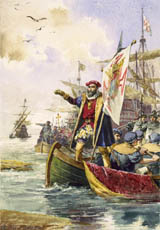


Vasco Da Gama, The Royal Museum Greenwichīut the sea route to India was still unknown. But they all came through the land route or precisely via the infamous Khyber Pass. They were given the honour of a final resting place amongst kings.Many sailors from the Western world sailed to discover the land in the Far East called India - a land fabled to be richer than all the known worlds put combined.īut none succeeded except for Vasco Da Gama, a Portuguese sailor who became the first European to land in India on when he landed on the shores of Calicut in Kerala with four vessels.Ĭhristopher Columbus who had started his voyage in 1492, five years before Da Gama too wanted to discover the sea route to India, but instead reached the Americas, the world completely unheard before then.īy then India had already seen many foreign invaders in the form of Alexander -The Great, the Arabs, and the Mongols.

Vasco da Gama (on the left-hand side) and Luís de Camões (on the right-hand side) were the two most important representatives of this epic period in Portuguese history. Their tombs, made by the sculptor Costa Mota are now in the lower choir of the Monastery's church.

In 1880 the remains of Vasco da Gama and the poet, Luís de Camões, were transferred to the Jerónimos Monastery. Through their daring and fortitude, Vasco da Gama and his crew overcame the fury of the heavens, seas and land to write a new page in the history of the world.ĭa Gama's remains were brought from India to the monastery of Nossa Senhora das Relíquias near the town of Vidigueira, where they remained for three centuries. The chronicles of this time tell us that Vasco da Gama was 'of medium stature, of knightly genius, daring for any grand or risky achievement, rough when giving his orders, strong enough to be feared in any dispute, hard working and inflexible in his punishment on behalf of justice'. His older brother was Paulo da Gama, who travelled with Vasco on the voyage to India of 1497-1499 and died almost at the end of the return journey at Terceira Island in the Azores. He was the second son of Estêvão da Gama. Vasco da Gama was born in Sines, probably in 1468, and died in India in December 1524, only three months into his term as viceroy of Portuguese India.


 0 kommentar(er)
0 kommentar(er)
